Vinegar Syndrome October releases, part one
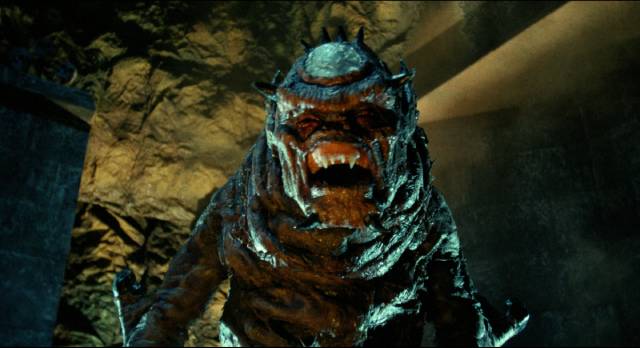
Receiving my monthly package from Vinegar Syndrome feels a bit like Christmas. Because I’m a subscriber, I actually paid for these new releases months ago, before I even knew what they would be. I took that chance based on previous experience, trusting that I would be interested in whatever they decided to release, and for the most part I haven’t been disappointed. Being a subscriber also removes the stress of trying to decide whether I should order a particular title or not. There have been a couple of duds, movies I wouldn’t have actively ordered, but even receiving those has a kind of “unexpected gift” feeling. The October shipment actually arrived just two days after my birthday, so that increased the sense of gratification.
This particular package included all five of the new releases plus an older title and one partner release, for a total of twelve features in all. And having a few days off work, I binged my way through them. So here are a few comments in the order in which I watched the movies:
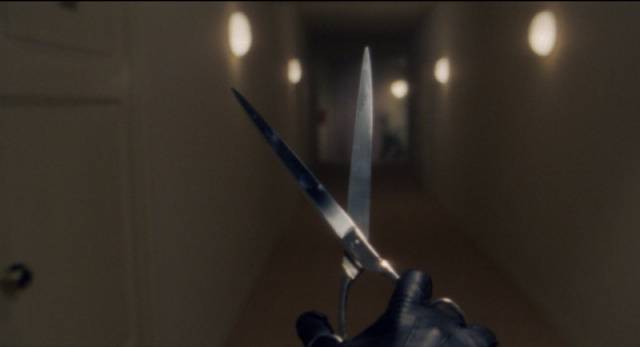
Nothing Underneath/Too Beautiful to Die
(Carlo Vanzina/Dario Piana, 1985/1988)
This two-disk set presents a pair of mid-’80s gialli which, despite their Italian titles linking them, are unconnected except for their setting in the fashion world. Carlo Vanzina’s Nothing Underneath (Sotto il vestito niente, 1985) hangs on a gimmick slightly reminiscent of those in early Argento movies (like the chromosomal causes of homicidal mania in Cat O’ Nine Tails and the retinal photography in Four Flies on Grey Velvet, both 1971). Here it’s a psychic bond between twins which allows American park ranger Bob Crane (Tom Schanley) to have a vision of his sister Jessica (Nicola Perring), a model working in Milan, under apparent threat from a killer. When he can’t contact her, he flies to Italy and tries to convince skeptical police inspector Danesi (Donald Pleasence) that she may have been murdered.
Naturally other murders occur before the killer and Jessica’s fate are revealed. The device of Bob’s visions is used erratically – though the link is with Jessica, he seems to be seeing through the scissor-wielding killer’s eyes, and they continue after Jessica’s death. On the plus side, there’s a stylish Pino Donaggio score and Pleasence gives his usual amusing supporting performance.
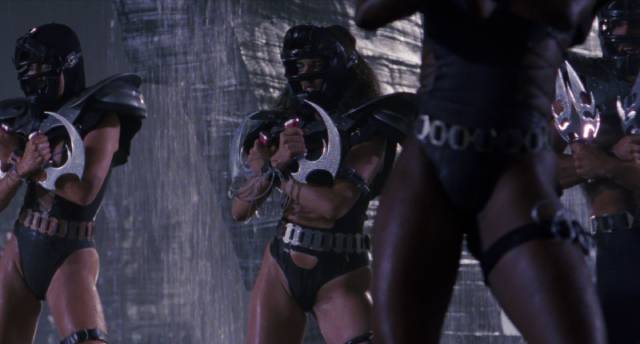
The in-name-only “sequel” Too Beautiful to Die (Sotto il vestito niente 2, 1988) was the first feature of director Dario Piana, who only has a few credits but apparently had a long career directing commercials. Again centred on a group of models, this one revolves around the shooting of a music video repeatedly interrupted by murders committed with a collection of prop blades. The slaughter is triggered by a particularly nasty rape sequence followed by the victim’s death, which involved her co-workers. Given Piana’s commercial experience, it’s perhaps not surprising that the movie’s strongest point is a steady stream of stylish visuals which frequently take precedence over the storytelling.
Both movies are minor additions to the giallo catalogue, made as the genre was already into its decline, but both offer a few striking visuals and occasional glimpses of the twisted appeal the giallo possesses, while harking back to the genre’s origins in Mario Bava’s Blood and Black Lace (1964).
*
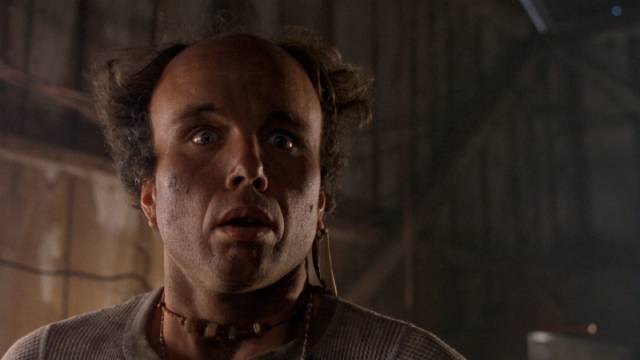
in Tony Randel’s Ticks (1993)
Ticks (Tony Randel, 1993)
Perhaps the biggest surprise in the bunch was Ticks (1993), which VS has given the deluxe treatment with a 4K UHD/Blu-ray combo release. I really only know director Tony Randel through his connection to the Hellraiser franchise, having made his directorial debut with Hellraiser 2: Hellbound (1988), a clunky but inventive riff on the perverse world Clive Barker had invented the previous year. Randel’s background was in effects and the editorial department, having done a bunch of (often uncredited) fix-ups on movies acquired by Roger Corman’s New World Pictures (including Hellraiser itself).
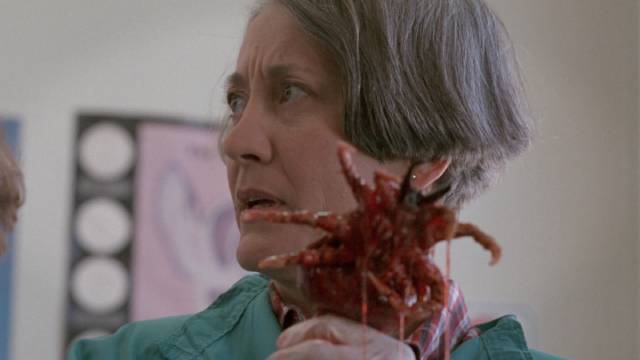
I’d never seen Ticks because I had the impression it was just another dumb big-bug B-movie. Which is essentially what it is. It draws on one of the cheesiest tropes of ’80s horror – a bunch of kids off in the woods at a remote camp who are destined to be killed off one by one – but replaces the masked killer with deadly bugs. The set-up is handled efficiently in both Brent V. Friedman’s script and Randel’s direction, quickly introducing a group of troubled city kids who are being shipped off for an experience of Nature, which is supposed to help them deal with their issues. In charge are empathetic Holly Lambert (Rosalind Allen) and her boyfriend Charles Danson (Peter Scolari), who is treating the kids as research subjects.
Before they get to the cabin, the audience has already been prepped for the horror to come with the introduction of Jarvis Tanner (Clint Howard), who’s in charge of a barn where toxic chemicals are prepared for use on the local marijuana crop. Those steroid-based chemicals are leaking all over the place and create giant mutant ticks, which quickly infest Jarvis and spread out through the woods, where the trees are heavy with their sticky egg sacs.
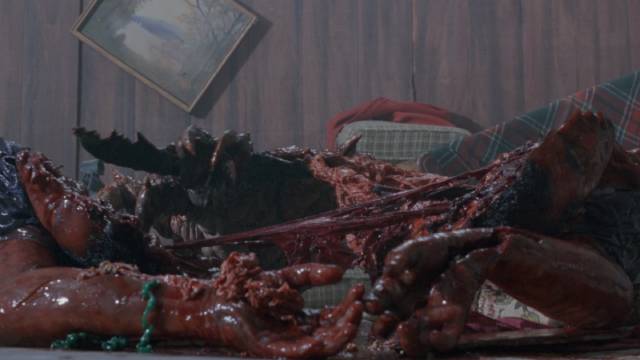
While the kids bicker with one another and distrust Holly and Charles, the ticks go into action and the second half of the movie is a classic siege story; once everyone is aware of the threat (of course, the adults initially don’t pay any attention to what the kids try to tell them), it’s a fight for survival against hordes of skittering bugs which climaxes with one giant tick tearing its way out of a body. Randel actually devotes time and attention to the characters, stock though they might be, so we like them enough to care when they’re under threat, with a small amount of comic relief limited to Howard’s struggle in the barn as his body becomes infested.
But what really puts Ticks above other movies like it is the excellent effects work of Doug Beswick and his crew. Pre-CGI, all the bug action is handled live on-set with puppets and animatronics, and it’s all impressively executed so the movie never succumbs to the inherent danger of silliness. With a decent cast playing it straight and great effects, Ticks is way more engaging and entertaining than I expected.
*
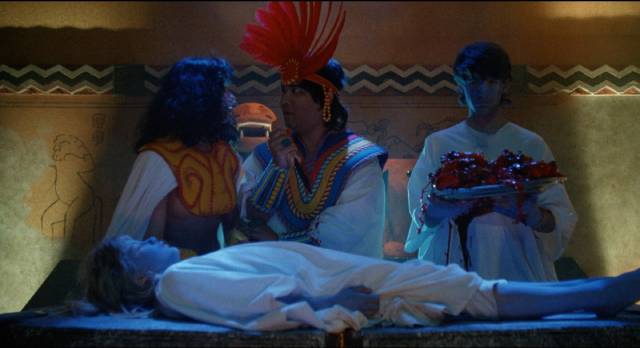
The Laughing Dead (Somtow Sucharitkul, 1989)
I had no expectations at all regarding The Laughing Dead (1989) as I’d never heard of it before this release. But I can honestly say that I was unexpectedly entertained as a rather slow and slightly clumsy story takes off in the second half with escalating weirdness that reaches a completely batshit crazy climax that has to be seen to be believed. Given the director’s Thai name and the setting during Mexico’s Day of the Dead, I was primed for the off-beat folklore-based fantasy-horror of low-budget Asian and/or Mexican genre movies. But something clicked as the credits rolled when I saw that it was written by S.P. Somtow, a name that seemed vaguely familiar. A quick search revealed that S.P. Somtow and Somtow Sucharitkul were one and the same – an award-winning Thai-American sci-fi and fantasy author – here trying his hand at filmmaking for the first time.
Somtow also appears in the movie as Dr. Um-tzec, the Mayan god of death who is about to usher in a new age (and hoping to hand over God duties to a successor so he can get on with being a stock trader). Somtow’s plump body and round face make him an amusingly unthreatening menace; in one sequence as he sacrifices a bunch of kids on a kind of assembly-line altar, the still-beating hearts piling up, he complains about the tedium of his apocalyptic task.
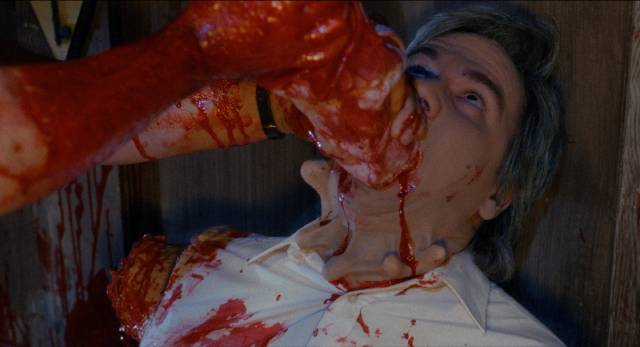
Eventually opposing Um-tzec is Father O’Sullivan (Tim Sullivan), a priest whose faith has lapsed because of past transgressions – he fell in love with a nun who became pregnant and was kicked out of the Church. Now the priest is an expert on meso-American archaeology and is taking a group of students and tourists down to Mexico to explore some ruins during the Day of the Dead celebrations (actually filmed in Tucson, Arizona). Along for the trip is none other than Tessie (Wendy Webb), the former nun, with her foul-mouthed and unruly son Tommy (Billy Silver), who doesn’t know that the priest is his dad. The rest of the group consists of an annoying New Age couple obsessed with crystals and vibrations and a couple of obnoxious men who tell jokes that were already old when the Catskills were crawling with crude comedians.
The group become trapped in a small Mexican town and adherents to the ancient Mayan religion start killing them off. It turns out that the priest is destined to assume the role of god of death and the vehicle for his transformation is to be the sacrifice of the son who doesn’t know his own father. Members of the group figure out what’s going on and, when the priest becomes possessed, have to try to stop the world-altering ceremony. All of this reaches its utterly bizarre peak when Um-tzec and the priest transform into giant reptilian creatures representing the clashing forces of darkness and light for a rubber-suited wrestling match. It’s all totally bonkers and strangely endearing, even with the occasionally graphic gore.
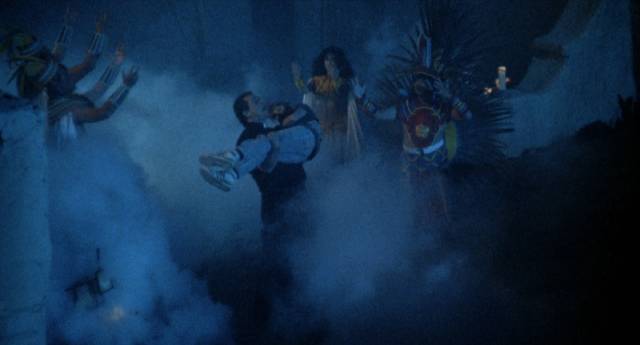
The Laughing Dead is one of those movies you probably have to be in the right frame of mind to appreciate. Made by people with little filmmaking experience, it continually breaks the rules of conventional movie-making – perhaps a reflection of its creator usually expressing his imagination on the page where there’s more creative freedom. The ways in which the film keeps flying off in odd directions, indulging in non sequiturs which are by turns baffling and amusing, is also probably due to the fact that – as Somtow says in the making-of on the disk – there really wasn’t a single controlling creative force; he didn’t actually want to direct and at various times as many as three other crew members would take charge on set.
Also interesting is the fact that there are few experienced actors in the cast, with Somtow having recruited a lot of other sci-fi and fantasy writers to play many of the roles. This gives the movie a feeling of friends getting together to play, like grown-up kids putting on a show for their own amusement. The results might not be what you’d call a good movie, but it’s colourful and inventive and pretty entertaining.
*
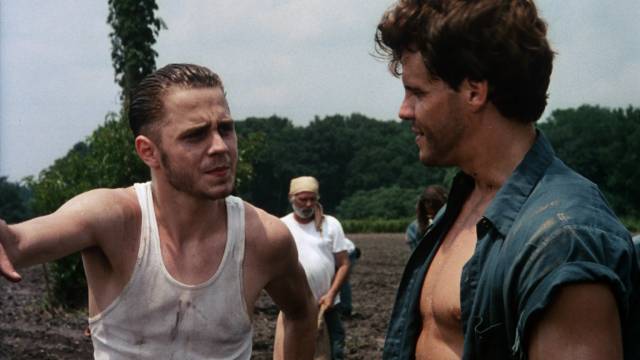
The Grave (Jonas Pate, 1995)
Another movie I knew nothing about before this release, by someone I’m unfamiliar with, The Grave (1995) is an atmospheric southern Gothic noir, which was no doubt influenced by both the Coen Brothers’ Blood Simple (1984) and Quentin Tarantino’s Reservoir Dogs (1992), though it doesn’t manage to reach their level of verbal and stylistic play. But I did find it entertaining and it’s packed with fine character actors, many of whom only show up for a single scene. Strangely, those brief glimpses manage to create the impression of a populated world, even though the story is small and tightly contained.
The first familiar face is Keith David, barely discernible sitting at a table in an underlit prison cell, listening to a prisoner with a raspy voice tell a story. We don’t see this storyteller except in silhouette until the final moments, but an astute viewer might guess their identity at some point as we return repeatedly to the cell. The story being told opens on a prison farm where men hack at the dry ground with hoes under the watchful eyes of guards on horseback. A weasely prisoner named Wex (Giovanni Ribisi) edges up to King (Craig Sheffer) and Tyn (Josh Charles) and offers them information about a supposedly hidden stash of treasure somewhere in the South. Initially skeptical, the pair finally show interest. And that’s the last we see of Wex.
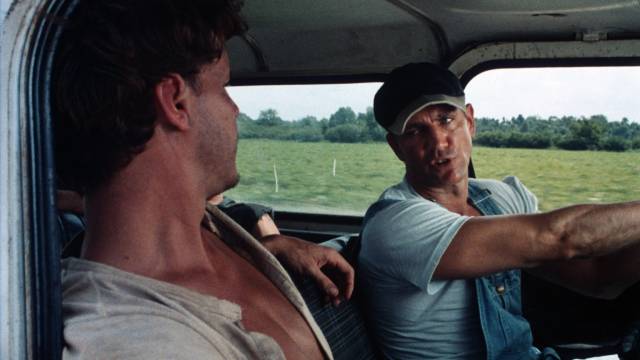
With the help of corrupt guard J.C. Cole (John Diehl), King and Tyn manage to break out and head for the small town where the treasure is reputed to be hidden in the grave of a wealthy man. Along the way, they stop at a cabin to steal clothes from a line and an old man shoots Tyn in the belly. King considers killing the old man, but it’s not in him. He drags the bleeding Tyn away and tries to hitch a ride on the highway. An old farmer stops, even though he recognizes what they are. As he drives, he tells them a seemingly pointless story which actually reveals his empathy and when they get to his farm, he gives them the keys to the truck and says he won’t report it stolen for a few days. The farmer, by the way, is played by Eric Roberts; we never see him again either.
Unable to go to a doctor or hospital, they make their way to a rundown funeral business owned by Travis Percell (Anthony Michael Hall), who happens to be the man who stole the car that King and Tyn were locked away for taking. Despite owing them, Travis doesn’t seem inclined to help, though he does eventually sew up Tyn’s wound. Meanwhile King goes to visit his old girlfriend Jordan (Gabrielle Anwar), who’s not too pleased to see him. Yet they do eventually go to bed together.
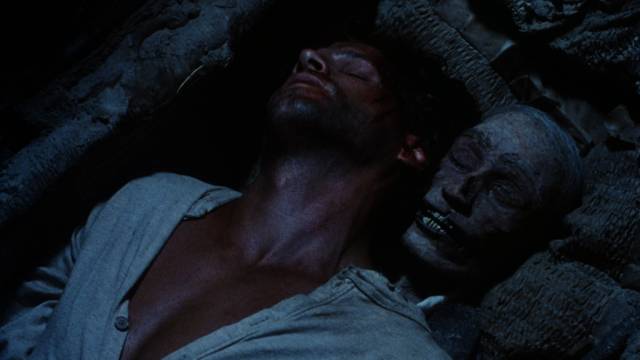
While he’s there, Travis manages to get the story from Tyn just before he dies from blood loss, and Travis heads for the graveyard with his redneck cronies Cletus (Donal Logue) and Boo (Max Perlich). All they find, though, is a gold ring; hearing someone approach, Boo hits the intruder, who turns out to be King, with a shovel. Believing him dead, they toss him in the open coffin and refill the grave and take the ring to Jordan, who happens to own an antique store. She says it’s one of a pair and the Latin inscription can only be deciphered when she has both … so back they go, only to find that King is still alive. They have to form an uneasy alliance.
Meanwhile, Boo has fallen into the hands of J.C. Cole, who tortures the story out of him before drowning Boo in a river. So the threads come together – the rings give the location of the treasure; King, Jarvis and Cletus discover the vault beneath the graveyard; and Cole closes in to claim it all… But inevitably things go wrong, someone unexpected throws a wrench in the works, and everyone ends up dead except for the one who’s telling the story in that cell through the night as they wait for their appointment with the electric chair at dawn. Keith David, it turns out, is the priest who’s there to hear the final confession.
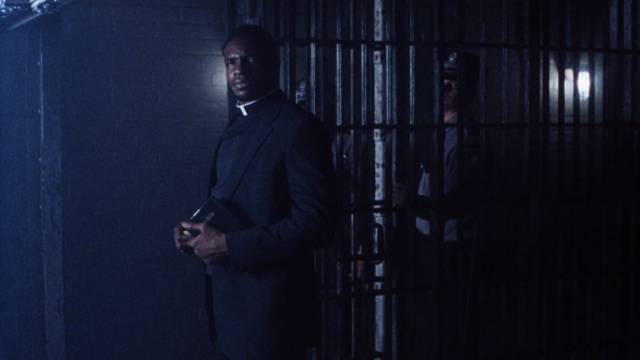
The script by Jonas and Josh Pate is neatly constructed and the cast breathe life into the characters, but it doesn’t sparkle and soar the way a Coen Brothers movie can. I’m not quite sure what exactly is missing – it’s well-paced, Frank Prinzi’s photography is full of pleasing textures and moody shadows. Maybe it’s nothing more than that the story is a bit thin and stretches plausibility with that treasure vault beneath a country graveyard. The narrative needs to be grittier, but lands at the end in juvenile fantasy. Whatever, I found it entertaining enough.
To be continued…
Comments
I looked it up and I saw The Laughing Dead on 12/23/89. I really enjoyed it. It was because Greg is good friends with Somtow, he got a VHS of the movie and I borrowed it to watch. It didn’t get much of a release back then and that copy of a copy was what I had for ages. Now I need the new Blu-ray. I’m just waiting until they have a bit of a sale. Greg also got a free copy of the Blu-ray, VS had had a pop up sale at DreamHaven a month or two ago and they sent a dozen free discs to him for inviting them. They said they sold more discs than at the last couple of conventions they were at. Greg’s talking to them about carrying the films in the store. That would be handy, especially if he still gives me my discount of 20%.
If you’ve only seen it on a bootleg VHS, it’ll seem like a whole different movie on Blu-ray!